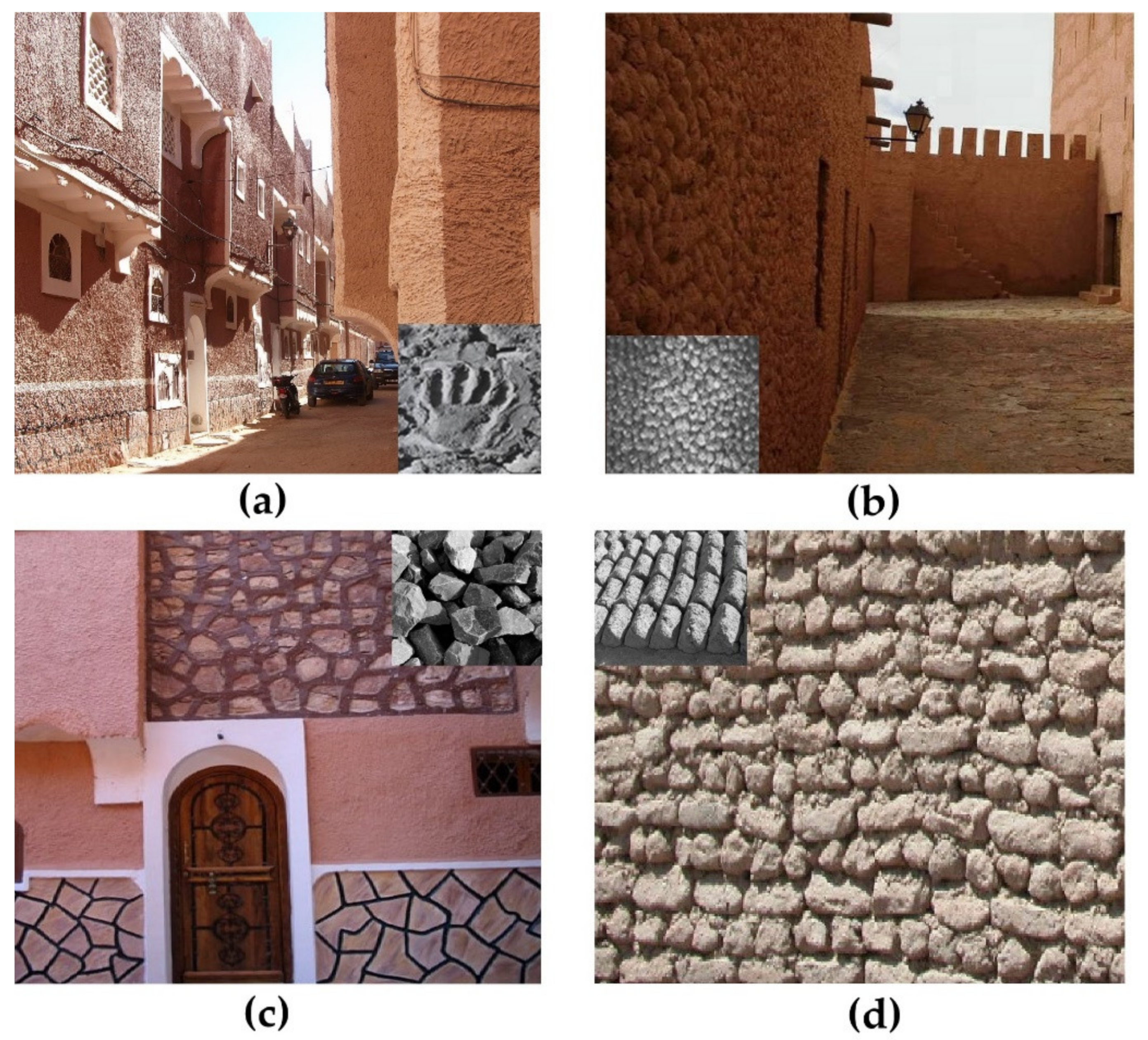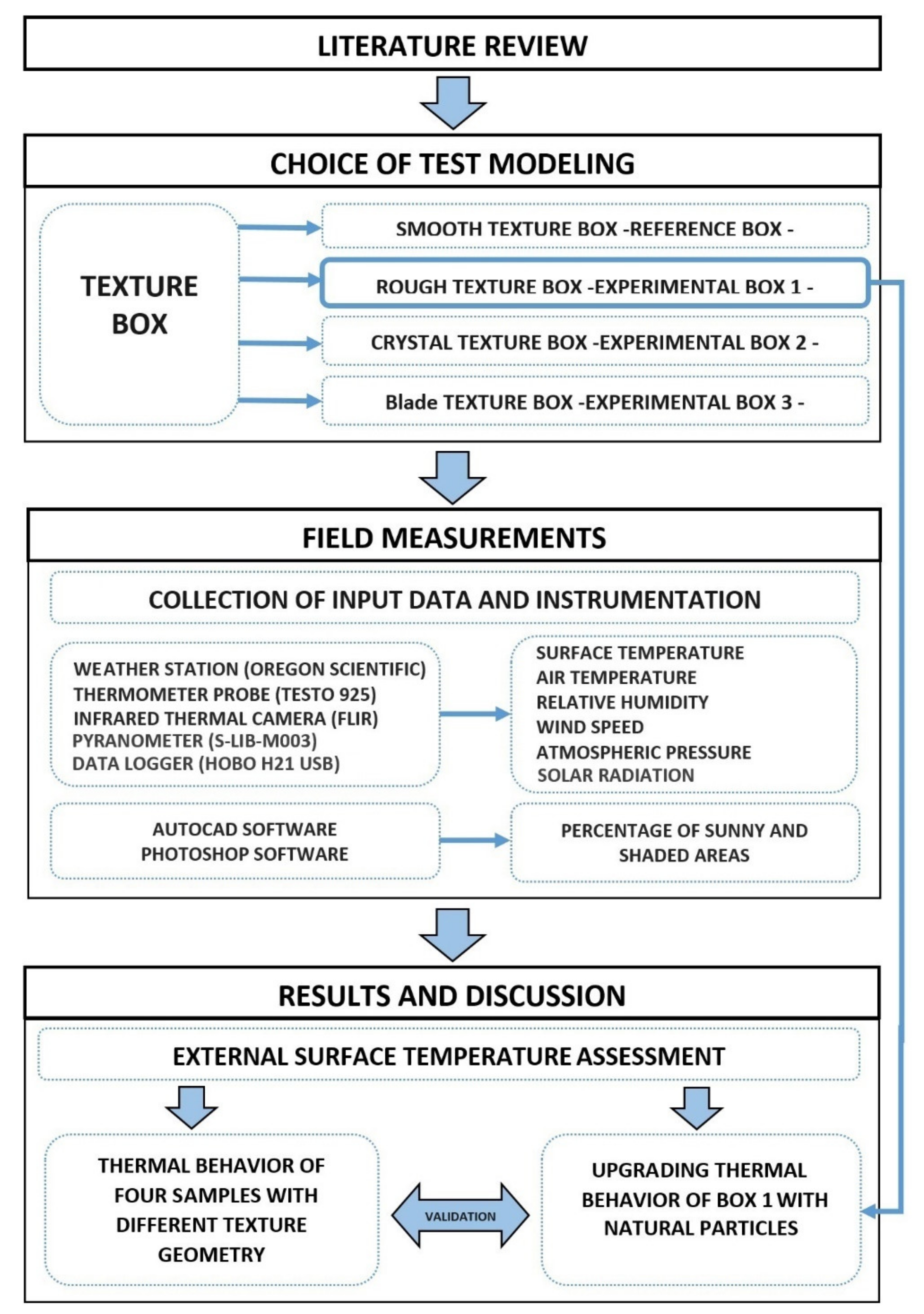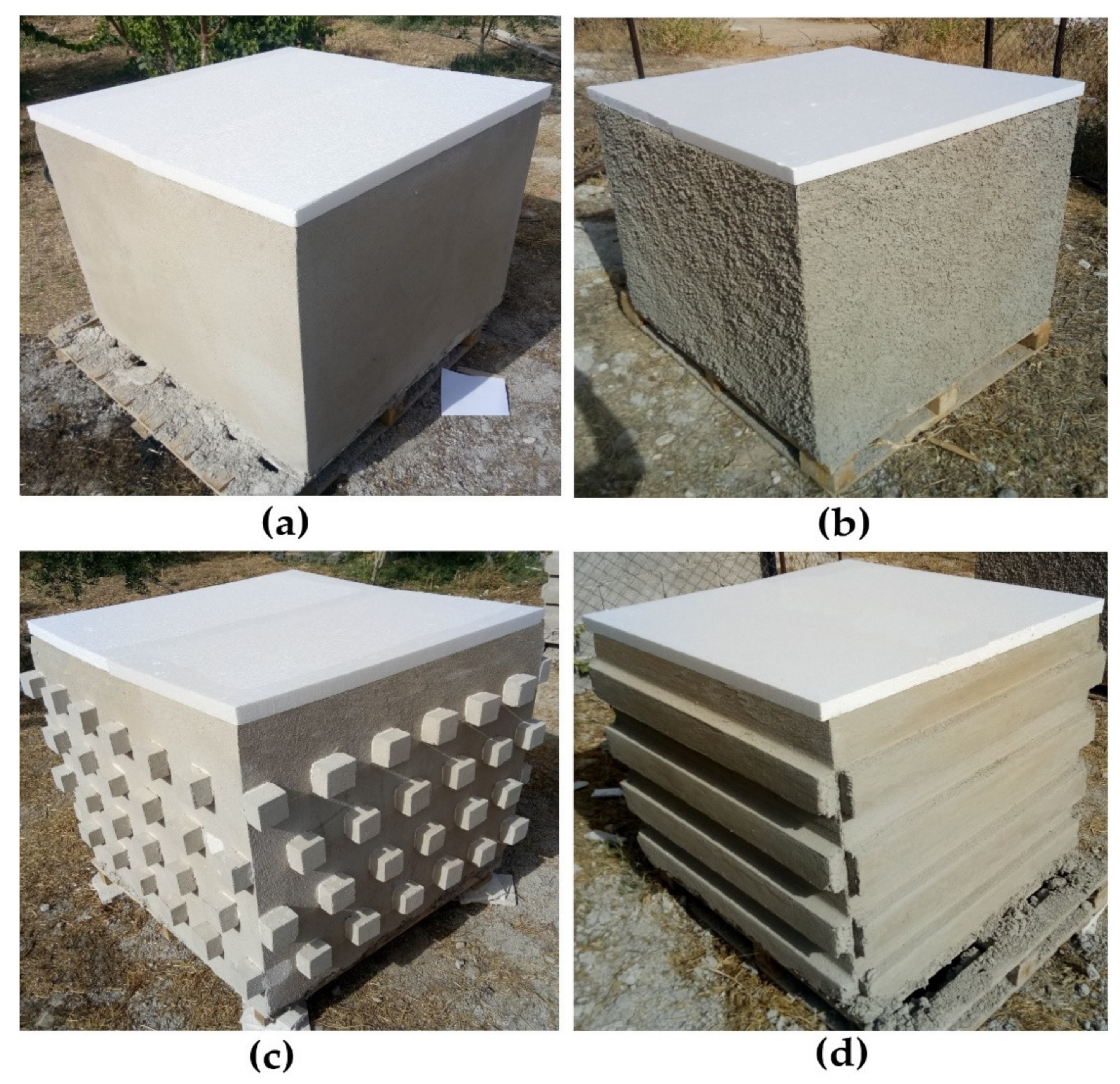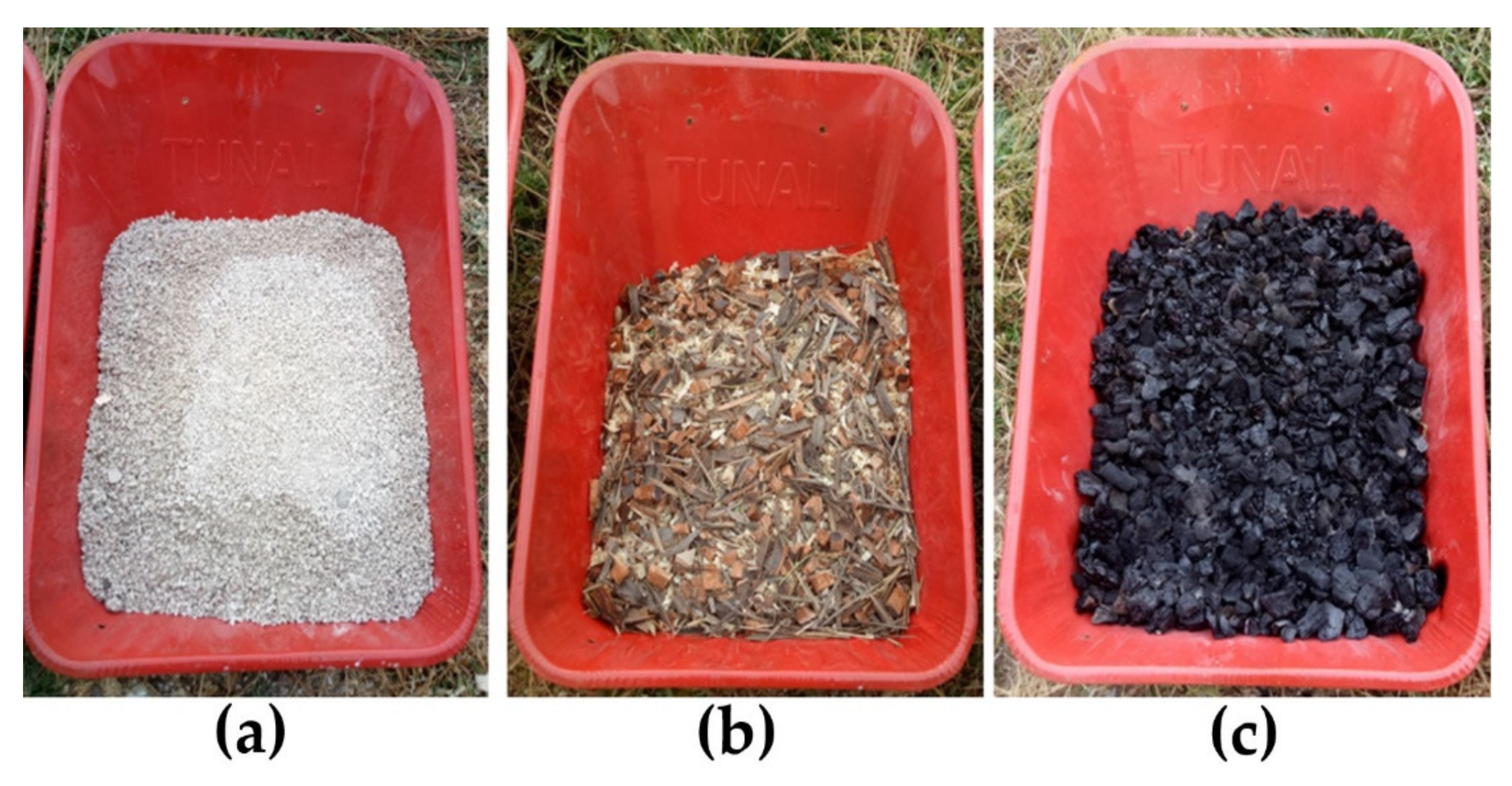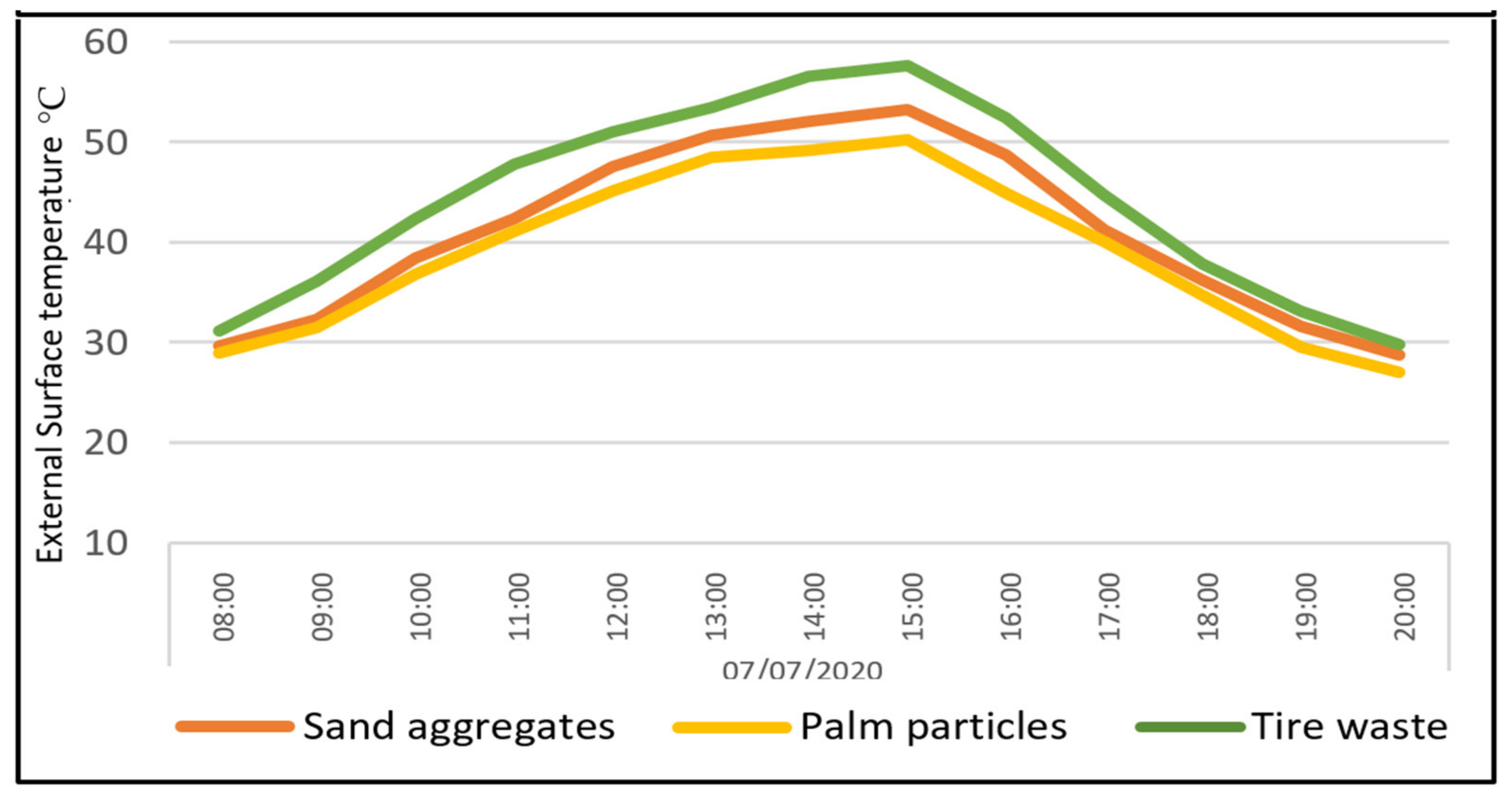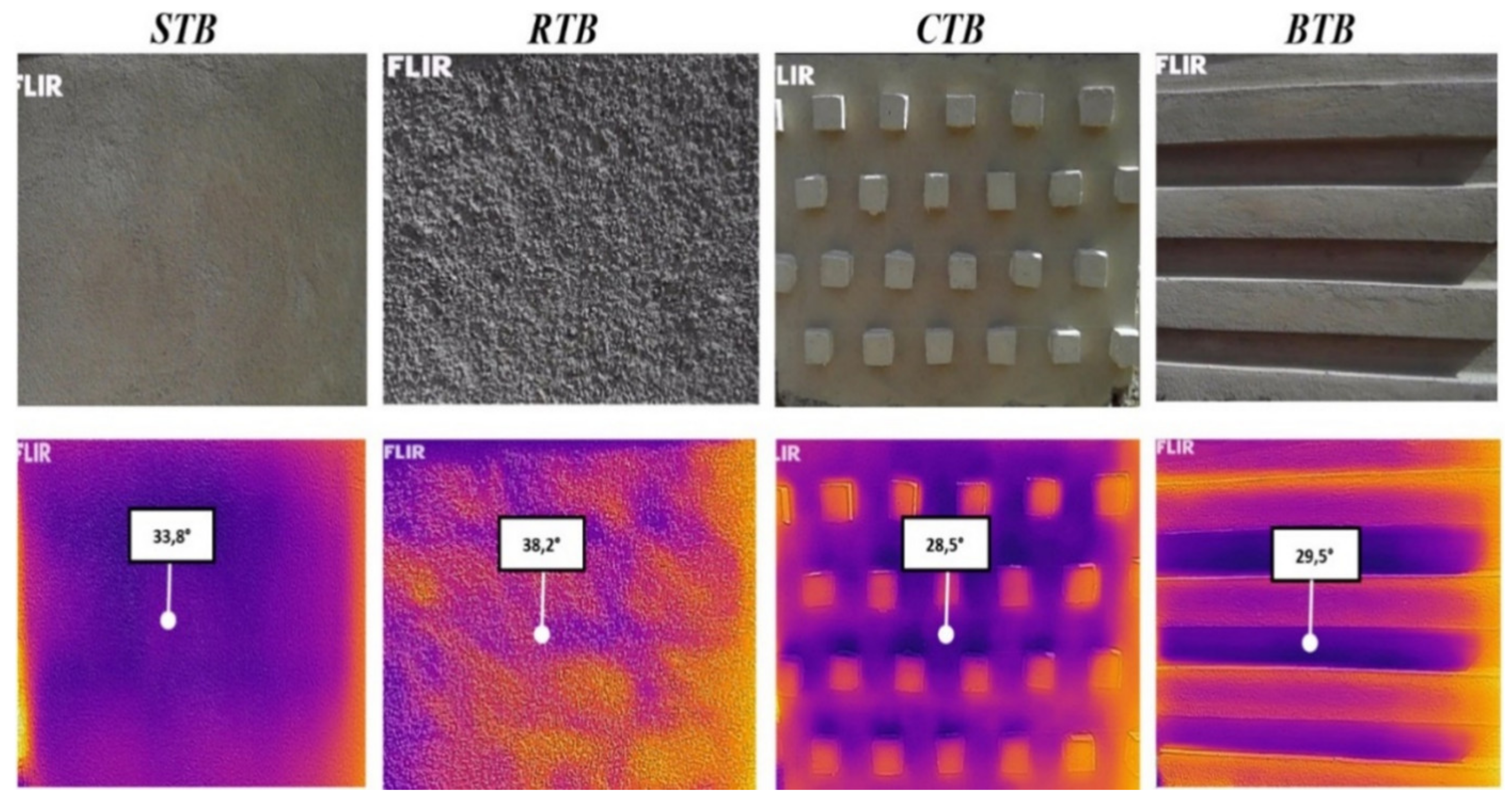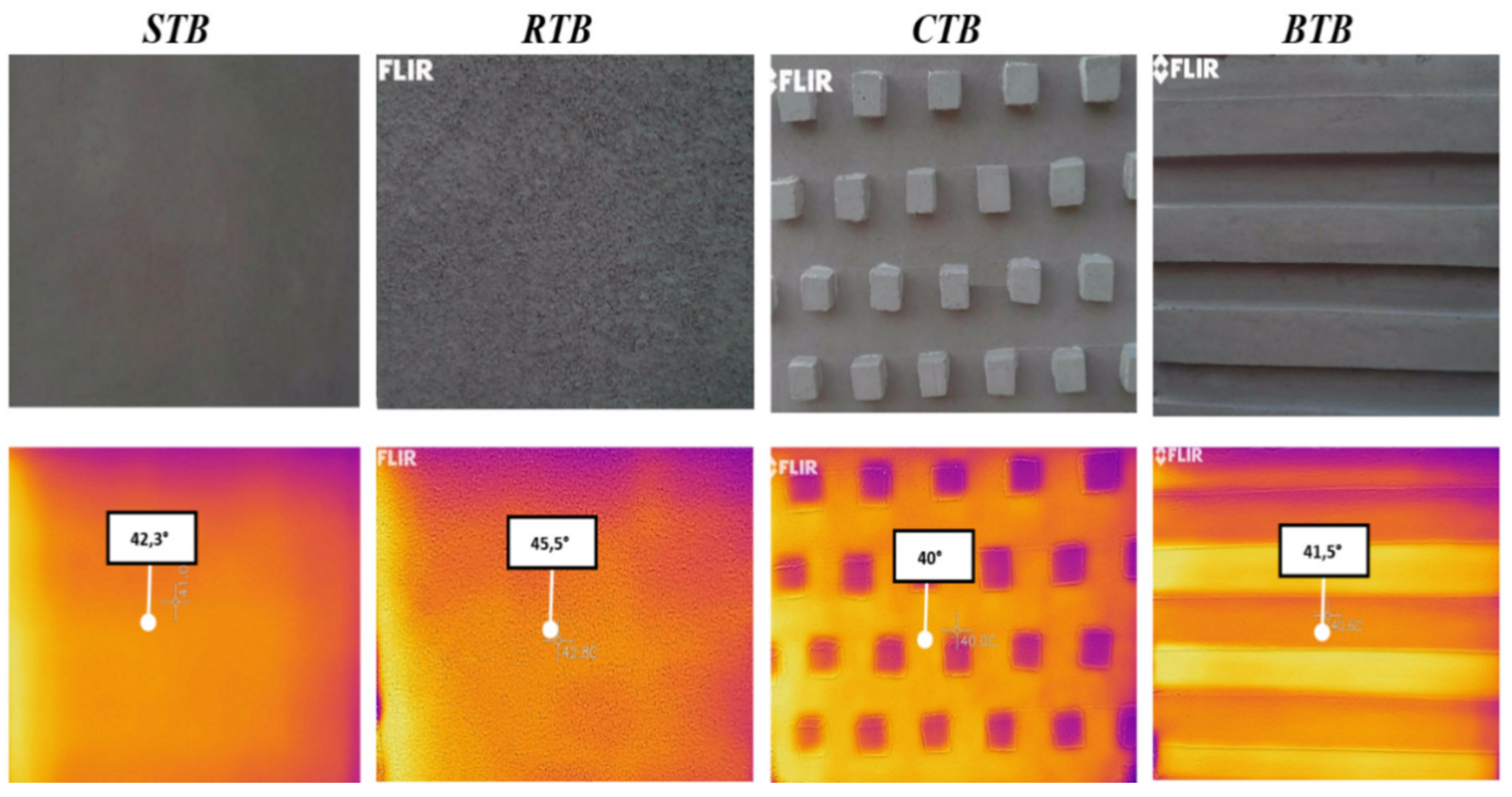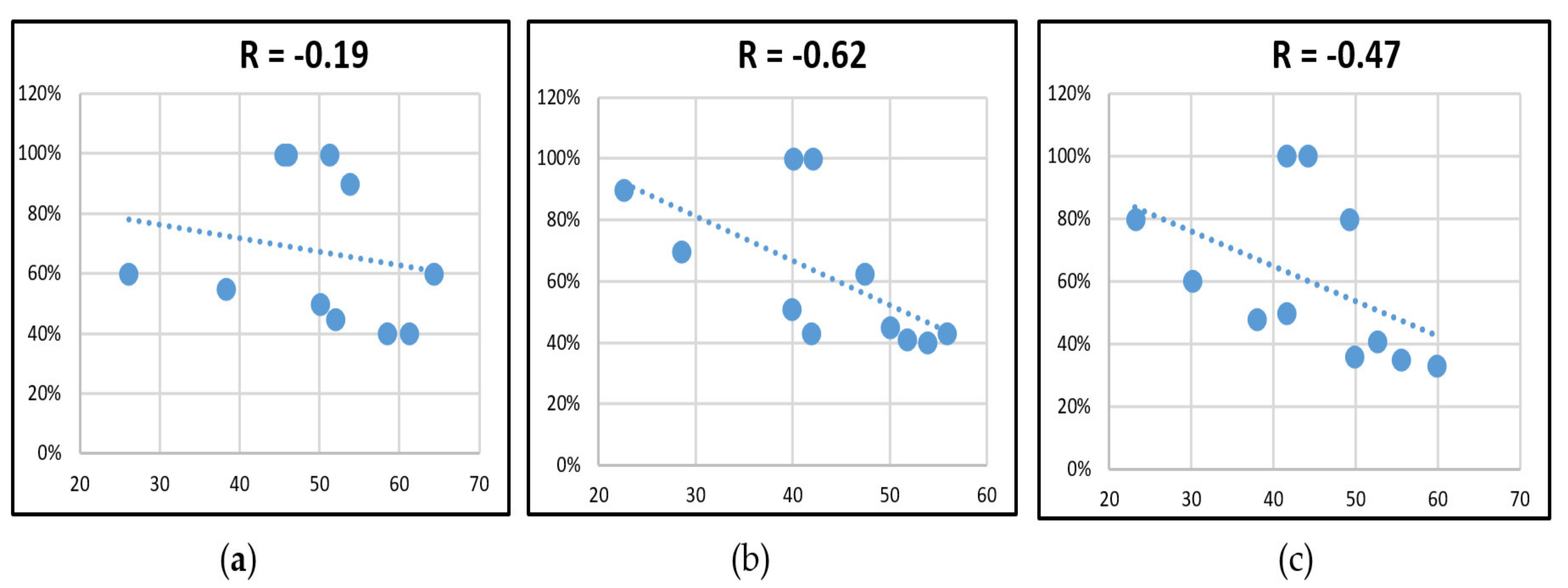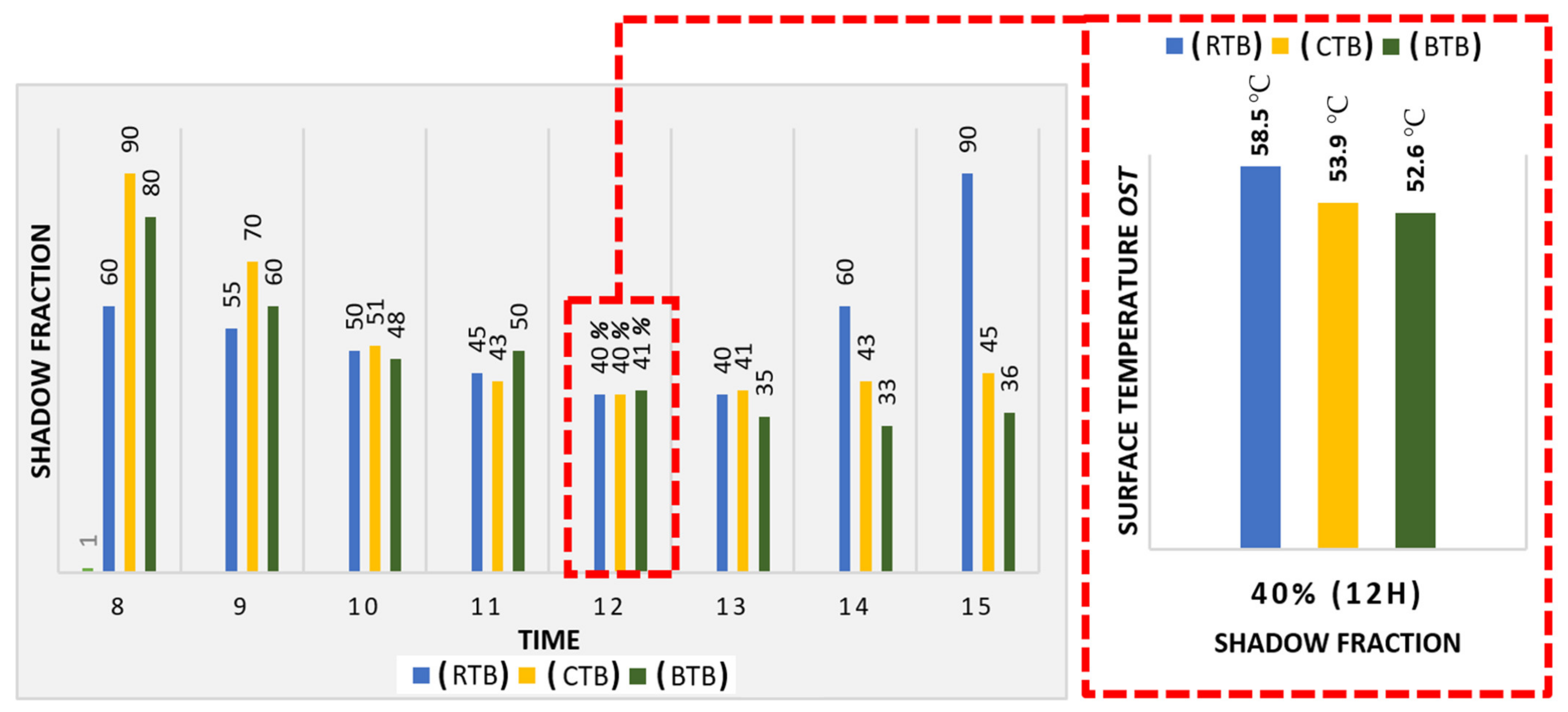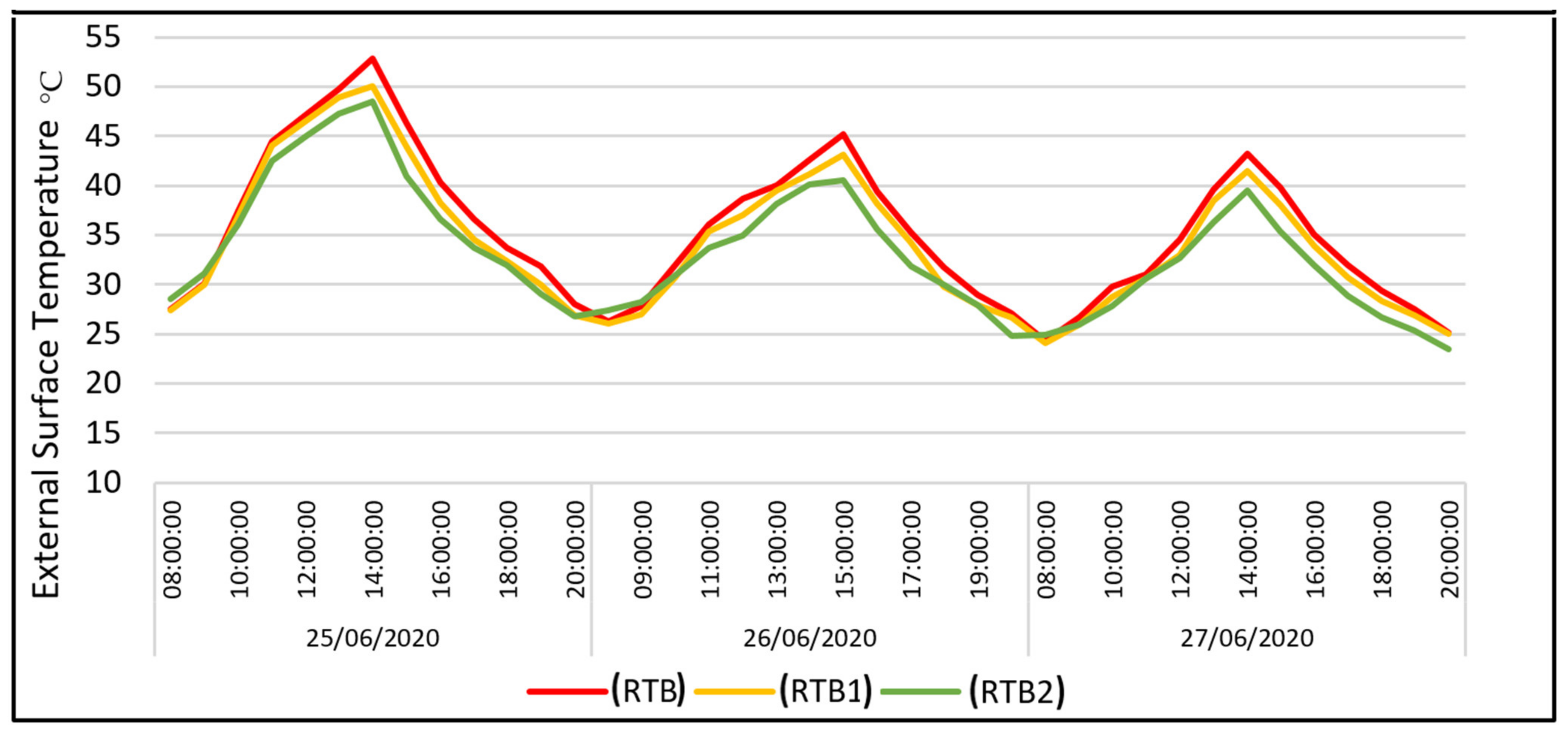1. Introduction
Climate change is one of the most debated topics of the 21st century. The planet has experienced phenomena caused by this change, such as rising temperatures, heat waves, rising sea levels, more intense storms, and forest fires. Since 1930, Over 100,000 new chemical compounds have been developed, and there has been missing information on the health assessment of such chemicals, of which a large portion are used in construction products. For example, Portland cement concrete, which is the most widely used material on the planet (10,000 million tons/year, and which, in the next 40 years, will increase by about 100%), contains chemicals used to modify their properties, fresh or hardened, whose effects on health and the environment are not yet fully understood [
1].
The building envelope is an outer skin enclosure that can exclude unwanted effects while admitting desirable ones; it plays a crucial role in improving building energy efficiency and indoor comfort for the occupants. The choice of the external envelope is the first issue to be considered in the building energy-saving design. The next decision is to determine the suitable exterior cladding material and texture for optimizing energy efficient. These elements come in diverse categories (slate, brick, cement, plaster, marble, painting.) used for covering outside, consolidating, protecting, or decorating walls. These can also influence the energy consumption and improve indoor thermal comfort through their texture. To approach this research, we will review the three primary related areas: external coating, self-shading, coating colors, and smart kinetic coating. A number of studies discuss traditional brick properties and patterns.
The thermal design of the building envelope is optimized in order to pursue two objectives: the minimization of primary energy demand for the annual space conditioning and the minimization of thermal discomfort hours.
Ascione et al. [
2] presented a study on external coating of the building envelope for two different cities, Naples and Istanbul, characterized by Mediterranean climates, in order to minimize the annual energy demand and maximize indoor comfort. The research explored different thermal properties of the coating, such as their aptitude to absorb or reflect the solar radiation, the infrared emission of the insulation, and the density and thickness of the masonry layers. The results in general showed that cool colors and cool materials were always suitable for hot climates, and peculiarly, the insulation of the walls should be high but not excessive. The high-reflective coating was also useful and reflected solar radiation, improving the cooling demand. Similarly, Yuxuan et al. [
3] studied the energy saving performance of thermochromic coatings with different colors for buildings in Shanghai. It was observed that the surface temperature of thermochromic coatings was lower than the ordinary coating during cooling period and higher than the ordinary coating during heating period. The results indicate that thermochromic coatings have better energy saving effects, especially for areas with hot summers and cold winters. Ibrahim et al. [
4] studied the thermal performance of exterior walls covered with a silica-aerogel-based coating. The results of this study showed that, for most of the cases studied, the aerogel-based coating showed better performance than other coating materials. Gagliano et al. [
5] studied synergistic effects of thermal mass and natural ventilation on the thermal behavior of traditional massive buildings in Italy; the results highlighted that the massive envelope of traditional buildings helped in maintaining small fluctuations of indoor temperature. This research also indicated that, for a Mediterranean climate, the increase in thermal insulation does not always induce positive effects on the thermal performance in summer, and that it might even produce an increase in the heat loads due to the transmission through the envelope. Joudi et al. [
6], in turn, studied the use of reflective exterior coatings to improve the thermal performance of buildings through different scenarios with reflective coatings. The results showed a correlation between the energy efficiency of the building and reflective coatings. Khadraoui et al. [
7] evaluated the impact of coating in the form of a ventilated façade on thermal comfort in arid areas. The study showed that the building with this system was more efficient than a reference building. The arrangement of terracotta elements is very effective as a multifunctional envelope, serving to protect the building, increasing its energy performance, and improving its aesthetic appearance.
Several studies have also evaluated the thermal performance of exterior coatings through self-shading walls. In Israel, Capeluto [
8] studied the energy performance of a self-shading building envelope; the results revealed that, for all the orientations, there was an important improvement in the energy performance of the building, particularly for east and west orientations. Other research, conducted by Alhuwayil et al. [
9], studied the impact of an external shading strategy on the energy performance of building in hot-humid climates; the results showed that the proposed shading could save the annual energy consumption of the building by 20.5% compared to the base case. The payback period for the additional investment required for incorporating the self-shading strategy is estimated to be 2 years. Liu et al. [
10], in turn, studied the impact of self-shading on buildings in Hong Kong; this study proposed the adoption of shading devices on opaque façades and evaluated their energy saving potentials in summer conditions. The results showed that, with the optimization of variables, such as the length, the number, and the angle of inclination of the shading panels on facades facing west, an energy saving potential up to 8.0% was possible. In other research, Kandar et al. [
11] studied the influence of self-shading strategy of inclined walls on the energy performance of buildings in hot and humid climates. The results showed that the self-shading projection with an angle of more than 45 °C could reduce the heat gains of the building envelope; an optimization with an angle of 65 °C to the horizontal plane gave the best performance results, which led to a decrease in energy consumption. Merhan [
12] studied the self-shading walls to improve environmental performance in desert buildings; the study aimed to present proposals to create shadows on opaque solid walls. The results showed that the self-shading wall strategy succeeded in reducing the outer surface temperature and incident solar radiation compared to the base case.
Other explorations have studied the effect of albedo on the external surface temperature, neglecting the texture of this colored face. Among these researchers, Mansouri et al. [
13,
14] evaluated the effect of the albedo in the exterior envelope on reducing the energy needs of buildings while varying the color. The results showed that the building envelope with a high albedo (0.9) recorded much lower values compared to the reference building with an albedo of (0.5). Bansal et al. [
15], through an experimental study of samples, found that a black wall recorded a surface temperature 7 °C higher than a white wall during the hot period of the day, which means that the albedo plays a major role in determining the surface temperature. Taha et al. [
16] carried out a study on exterior coatings characterized by high albedo. The results showed that, in summer, white elastomeric coatings were cooler than black elastomeric coatings. Coatings with high albedo in hot climates reduced the amount of incoming solar radiation and kept the building surfaces cool.
Other researchers are studying revolutionary technologies, such as phase-change materials, smart and kinetic envelopes, and design of a solar envelope, because their application improves building energy efficiency, which is a challenge that architects face today. The study by Tarabieh et al. [
17] explored the impact of brick bond types on building energy. The brick wall models were classified into three cases: ¼ brick extrusion, ½ brick extrusion, and base case (smooth) for each brick bond (Running, English, and Flemish). The results showed that the Flemish bond case was the best performing, followed by the English bond. The percentage of extrusion seems to play a very important role in the results. Ben Bacha et al. [
18] simulated the effect of shading devices on the building envelope with a kinetic system that actively reacted with weather conditions. The results obtained from this research showed that kinetic facades equipped with PV modules reduced direct radiation by 17.9%, which contributed to a decrease of indoor air temperature ranging between 4.0 °C to 4.8 °C. Other research, conducted by Ercan et al. [
19], presented a parametric numerical simulation methodology. This study generated shading devices in the building envelope in hot and humid climates that could optimize daylight while blocking excessive solar heat gain. The design alternatives have been generated by scalable algorithms in accordance with daylight performance requirements. Research conducted by Nocera et al. [
20] studied the adaptation of historic buildings reused as school buildings in order to optimize daylight; the results of this study proposed different technological and modernization solutions at the level of coating and built the envelope to improve visual comfort while respecting the cultural and historical value of the building heritage. Thus, these interventions can also be used in other regions of Europe with similar climatic conditions. Rodonò et al. [
21], in turn, presented a method for the production of composite materials and their mechanical and physical characterization; the objective of this research was to create a new composite material that could be folded and unfolded easily in order to give lightweight solutions for exterior building envelopes.
In addition, several experimental studies were done using ecological, organic, or recycling components in the building envelope, in particular, using plant components such as palm particles, because of these thermal and volume characteristics. This material has been used as aggregate in concrete, in wall structures, and as thermal insulation, but has not been used as a component for exterior coating. Benmansour et al. [
22] presented an investigation of new material, composed of natural cement, sand fibers, and date palm particles, in order to assess the usage possibilities of this new material as thermal insulation in the concrete. Several composites were prepared for different mass concentrations (from 0% to 30%). The results revealed that the incorporation of date palm particles, loading lower than 15%, satisfied both thermal and mechanical requirements of construction materials, and they could be used for wall structures. Other research done by Oushabi et al. [
23] investigated the morphological and thermal properties of polyurethane composites reinforced with date palm particles as new ecological thermal insulation materials in buildings. The composites were prepared with different loadings; 5%, 10%, and 20%. The results showed that the mechanical and thermal performance of this new insulation was competitive with those of other insulators available in the market. From this investigation, it could be deduced that palm particles reduced the thermal conductivity of the composite while reducing its weight, and they could be used for wall structures. Thus, its use as filler in the mortar seems to be a very promising option, which allows it to be applied as a thermal insulation material. In another similar approach, Záleská et al. [
24] studied the recycling of pneumatic waste (tire) mixed with cement concrete. The results indicate that the addition of these aggregates resulted in a decrease in weight, a deterioration of mechanical parameters, and a significant reduction in the thermal conductivity of concrete.
Based on the previous review, external coating plays a crucial role in improving building energy efficiency and indoor comfort for the occupants. Therefore, the choice of the external envelope is the first issue to be considered when making an energy saving building. In Algeria, the use of coating texture as a decorative element appears in a number of traditional architectural styles, especially in the southern part of the Algerian Desert, characterized by a hot and arid climate. In this part of Algeria, traditional buildings are built to cope with the harsh climatic conditions.
Therefore, the objective of this study is to evaluate the thermal behavior of the exterior walls with different coating textures inspired by traditional wall construction methods, as shown in
Figure 1. Traditional construction used self-shading walls as a cooling strategy for reducing the amount of incoming solar radiation. Therefore, it is important to determine the suitable exterior wall cladding texture and material for optimizing energy efficient buildings for hot climates.
2. Materials and Methods
The overall approach methodology of this research is illustrated by
Figure 2:
In this paper, the methodology we followed was based on the sequence of previous reviews. We started by studying the effect of wall texture geometry in decreasing the intensity of incoming long wave radiation in summer and lowering the external surface temperature. Then, another important motivation for upgrading the thermal characteristics of the investigated walls, we tried to incorporate natural particles (ecological, organic, waste, and recycling components) into exterior coating material. This research is beneficial for optimizing the thermal behavior of the building envelope in order to reduce energy use and provide comfort to occupants.
The present study consisted of two steps. The first series of measurements were carried out on four boxes with a one-meter dimension for each side (1 m3). After searching and investigating on the traditional texture in the south of Algeria [
25,
26], the choice was made on four types of textures, smooth texture (STB) as reference texture, rough texture (RTB), crystal texture (CTB), and blade texture (BTB), as shown in the
Figure 3. This operation was developed with the presence and assistance of a qualified builder. At this stage, the material chosen for building the exterior wall coating was composed of cement mortar with a thickness of 30 mm. The boxes were first tested and some thermal measurements were done before laying any texture coatings in order to avoid any kind of mistake. The four samples were provided with insulation at roof and floor level; the thermal transmission was almost zero. The obtained results without coating were similar.
The second step of this research consisted of studying the effect of incorporating natural particles (ecological, organic, waste, and recycling components) into exterior coatings. After research and development in improving thermal performance of the exterior envelope of buildings, a variety of particles were tested, and the selection was made of three types with different thermal characteristics:
Figure 4 shows a component from sand quarries, a component from ecological recycling (pneumatic waste), and a component obtained from collected date palm waste (palm particles). These waste materials were washed with distilled water to remove surface impurities and salt, then oven dried. These components were crushed and separated into different sizes, similar to the sand aggregate.
After many in situ test measurements, the choice was made on the palm particles, which showed the capacity to reduce the surface temperature more than the pneumatic waste aggregates. This choice was based on the ability to keep better thermal properties in order to reuse it as mortar aggregates in the manufacture of exterior coating textures. This material has been the subject of several research studies. It has shown high heat capacity due to its characteristics in reducing thermal conductivity, compressive strength, and weight reduction [
22,
23]. In addition, this material is widely available from date palms in the region of the great south of Algeria [
27].
Figure 5 shows the surface temperature difference of the three samples.
In order to evaluate the thermal behavior of the exterior wall textures, three boxes with a rough texture of (1 m3) each were constructed separately: (RTB), (RTB1), and (RTB2). Each box was made with different concentrations of palm particle aggregates (0%, 30%, and 70%) respectively.
Figure 6 shows the rough texture with different concentration of palm particles aggregate (0% and 30%) respectively.
Field Measurements and Instrumentation
In this experimental study, measurements were carried out in order to evaluate the thermal behavior of the exterior coating texture. This study was executed in Constantine city, situated in the northeast part of Algeria (latitude: 36.9126° N, longitude: 7.0213° E). Constantine is characterized by a hot and dry climate in summer. The experimental system (TEST BOX) was installed on a private garden in a cleared area, using different measuring instruments (FLIR type thermal camera—thermometers with connectable probe type (TESTO 925)) used for wall surface temperature. The external measurements were done by an (Oregon Scientific) type weather station used for collecting external climatic data and pyranometer (S-LIB-M003) with data logger (HOBO H21 USB).
Figure 7 shows the scientific instruments used for in situ measurements.
The measurements for the first phase of this study were taken on 2019 during the summer from June 23 to June 30 (08 days), the longest days of the year, where the hottest days were recorded on June 25, 26, 27, 2019. During this period, the weather station (Oregon Scientific) was installed in proximity to the test boxes and recorded a maximum of air temperature (AT) reaching 48.2 °C at 1:00 pm, a minimum of humidity of 6%, and an atmospheric pressure around 646 hPa. The solar radiation on a vertical plane recorded by the pyranometer was around 361 (Wh/m2) at midday.
The second phase of measurements was done during the summer period of 2020, choosing the same period, from June 23 to June 30. The output data were recorded from 12 h (8:00 a.m.) to (8:00 p.m.) with an interval of 60 min. The maximum air temperature (AT) recorded by the weather station (Oregon Scientific) was around 44.6 °C at 2:00 pm. The solar radiation on a vertical plane recorded by the pyranometer was around 328 (W/m2) at midday.
4. Conclusions
Natural cooling can be achieved by several strategies; in summer, shading is the most effective method to cool a building and reduces the cooling load in buildings. This study evaluated the effect of the wall texture coating in order to block the sun before it can get into the building, minimizing the short-wave solar radiation to decrease wall surface temperature. The experimental results report that there is a correlation between the texture geometry, the projected shadow percentage, and the surface temperature of the wall. The direct radiation has a big influence on surface temperature and conducts more heat to the building interior. This is well represented by rough texture, where the percentage of shading was lower and the surface temperature marked the highest values for the four studied orientations. However, crystal texture marked higher shading percentage and lower surface temperature, followed by the blade texture. The values of the wall surface temperature showed a considerable decrease after increasing the shading fraction, which caused a difference up to (5.4 °C) between the crystalline texture and the reference texture (smooth), and also had a difference of up to (9.5 °C) between the crystalline texture and the rough texture. Accordingly, the increase in the percentage of shading by the coating texture design can promote better results in lowering surface temperature; which has an impact in reducing the cooling requirements and increasing the thermal performance of the building.
For improving the studied walls efficiency and further reducing the cooling demand, the use of natural aggregates, such as palm particles with different concentrations, could provide significant advantages over sand aggregates used in the development of exterior coatings. The results showed that the use of palm particles as an exterior coating led to a surface temperature difference of up to (4.3 °C) compared to the reference texture. Therefore, using the right concentration of palm particles allows better surface temperature results in case they are mixed with adjuvants to avoid deterioration caused by weather conditions.
The future development of this experimental study is to establish further work that could include numerical simulations to assess the effect of exterior cladding texture on the thermal performance of walls. This survey opens up other research for different climatic zones of Algeria and other countries.
The present work falls within the framework of the preservation and enhancement of the building heritage in southern Algeria in order to contribute to the sustainable development of these regions characterized by a hot and arid climate.
